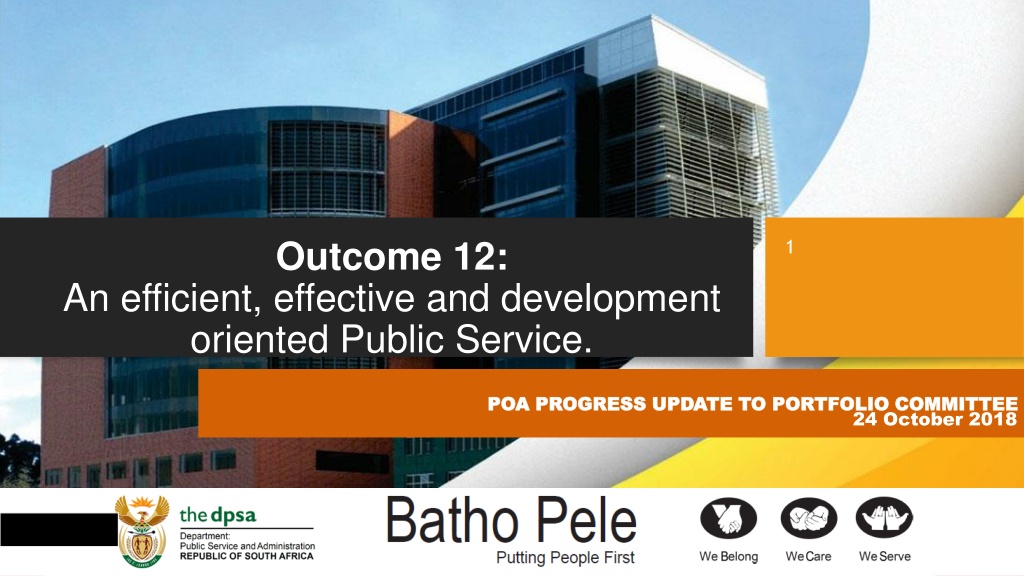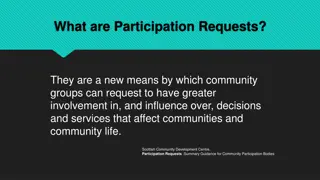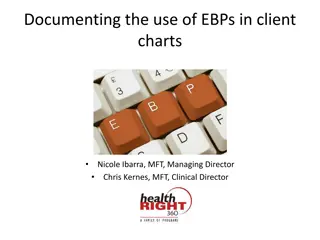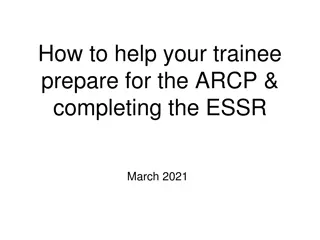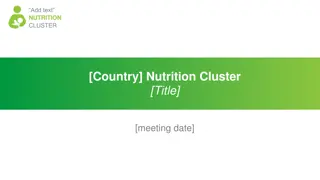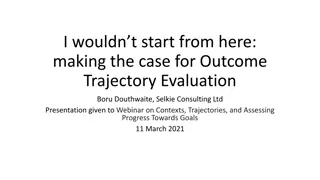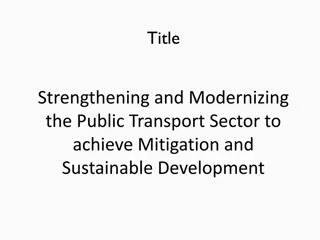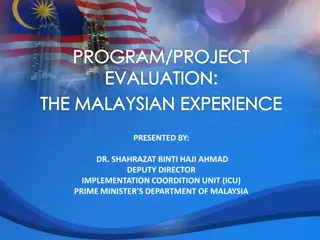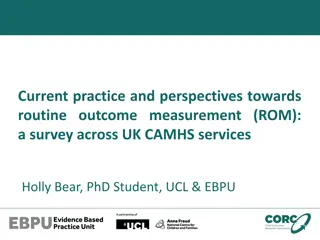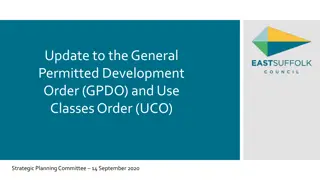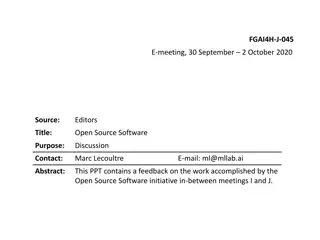Progress Update on Outcome 12: Public Service Development
Implementation progress report on Outcome 12 focusing on achieving an efficient, effective, and development-oriented public service. Key priorities, achievements, challenges, and remedial actions are highlighted, along with a review of the impact indicators for the Medium-Term Strategic Framework. The report outlines successful projects delivered by key partners and the overall satisfactory progress made towards the goals.
Download Presentation

Please find below an Image/Link to download the presentation.
The content on the website is provided AS IS for your information and personal use only. It may not be sold, licensed, or shared on other websites without obtaining consent from the author. Download presentation by click this link. If you encounter any issues during the download, it is possible that the publisher has removed the file from their server.
E N D
Presentation Transcript
Outcome 12: 1 An efficient, effective and development oriented Public Service. POA PROGRESS UPDATE TO PORTFOLIO COMMITTEE POA PROGRESS UPDATE TO PORTFOLIO COMMITTEE 24 October 2018 SECRET
Outline 2 Introduction Implementation Progress Report for the 2014-19 Medium Term Strategic Framework (MTSF) Chapter on Outcome 12: An efficient, effective and development oriented Public Service. Summary Achievements Challenges identified and the remedial action to meet these indicators, as reflected on the report. Review of the Indicators Conclusion SECRET
INTRODUCTION 3 The implementation of the 7 Sub-outcomes and 8 Impact Indicators of the MTSF Chapter on Outcome 12 that should be achieved by the delivery partners by the year 2019 and NDP VISION 2030 Progress Report provides an update on the SECRET
MTSF KEY PRIORITIES 4 The following sub-outcomes have been identified as critical outcome priorities based on Chapters 13 and 14 of the NDP. A. A stable political-administrative interface B. A public service that is a career of choice C. Efficient and effective management and operations systems D. Procurement systems that deliver value for money E. Increased responsiveness of public servants and accountability to citizens F. Improved inter-departmental coordination and institutionalisation of long-term planning G. Improved mechanisms to promote ethical behaviour in the public service SECRET
Summary 5 The seven (7) Sub-outcomes and eight (8)Impact Indicators of the MTSF Chapter on Outcome 12 contains 56 projects delivered by the following key partners: Department of Planning, Monitoring and Evaluation (DPME), Public Works (DPW), the Public Service Commission (PSC), National Treasury (NT), the National School of Government (NSG) and the PRESIDENCY. Of the 56 projects for the 2014-2019 Medium Term Strategic Framework (MTSF)reporting cycle 85% (48/56) are making satisfactory progress. SECRET
Achievements 6 THE FOLLOWING PROJECTS AMONGST OTHERS WERE ACHIEVED: Received Cabinet approval on the revised Performance Management Development System (PMDS) for both HODs and Senior Managers Improved on Recruitment systems of public administration and improved support mechanisms in the development of skills needed in the Public Service. Ensured that the Public sector workplace becomes a training space e.g the Development of mentoring and peer support mechanisms for senior managers E-enabled departments in e-Matric Systems, Electronic Integrated Justice System (IJS),Compensation filing(e- filing), Exam-Query system, and e-Services with Business. A comprehensive site assessment of Thusong Centres was conducted by both DPSA and offices of the premiers(location and accessibility) Provided support on the implementation of the Operations Management Framework (OMF). The OMF assists government institutions to plan, structure and execute and continuously improve operations for effective and efficient delivery to a number of departments both at National and Provincial level SECRET
Achievements 7 Assisted prioritised departments in core processes like the Business process improvement wheel and Standard operating procedures (SOPs). e.g DIRCO improved on the following selected core services: Cash Flow Management at Missions, Cash Flow Management at their Head Office, Payment and Logistics, and Management and monitoring of Medical Aid claims for officials broad Department of Environmental Affairs: Providing GIS Advisory Services Implementation and enforcement of Occupation Health (OHS), Safety Health Environmental, Risk Quality (SHERQ). National School of Government: Learner Records, Processing client enquiries and Training, Logistics Pockets of quality SDIPs at both National and Provincial spheres e.g Social Development in KZN where the department went on to receive both National and Provincial awards Launched the E-learning OMF/SDIP learning programme with the NSG where 377 Public Servants would be participating Introduced the e-disclosure system, extended the disclosure framework to other categories like Middle Management (MMS) and officials in Finance. Prohibited Public Servants from conducting Business with the state, Promulgated the Protected Disclosure Amendment ACT 2017 to amend the Protected disclosure Act 2000 SECRET
SUB-OUTCOMES 8 Sub Outcome 1: A stable political-administrative interface Summary: The approach proposed in the NDP is to ensure that EAs retain overall responsibility with a clear line of accountability between HODs and their respective political principals. The core focus of the 2014-19 MTSF is on developing administrative-level processes that bring greater predictability and stability to the management of the political-administrative interface. The first action was to: Create minimum level of PSA delegations from EAs to Accounting Officers (AOs) and other senior officials:- The delegations framework together with the guidelines were issued to departments 63% of all departments assessed complied with the Directive. This total compliance rate means that 99 out of a total of 158 departments assessed, complied with the Directive.(Three departments were exempted) At national level, 55% of national departments assessed complied with the Directive. The percentage compliance decreased by 13 percentage compared with 68% in 2016 and improved by only 2% since 2015 At provincial level, 66% of provincial departments assessed complied with the Directive. The percentage compliance increased with twenty four percentage points compared with 42% in 2015. SECRET
A stable political-administrative interface: Delegations 9 Total National and Provincial Departments Complying Total for the Public Service Total National Departments Total Provinces 2015 Percentage Compliance 2016 Percentage Compliance 2017 Percentage Compliance 2018 As at 30 August No. of Departments 2018 Percentage Compliance 45 64 61 99 of 158 63 53 68 52 24 of 44 55 42 62 64 75 of 114 66 SECRET
Political Administrative interface continued.. 10 The Second action was to develop improved administrative level processes run by the DG in the Presidency and the DGs in the OtPs on Management of HODs- Administrative head of the public service and of Provincial head of the public service (PRESIDENCY) is deferred to the next MTSF (Administration) There are 165 HoD posts in the public service (134 of this qualified to submit) only 96 (72%) managed to file performance agreements with DPME. The remaining 19% were either acting HoDs (18%) or newly appointed HoDs (1%). The remaining either submitted late or did not submit at all . Although some PAs were submitted after due date, all nine provinces achieved a 100% submission rate in 2017 but in 2018 only three provinces submitted on time. North West was the worst with only 18% submission on time and 82% submitted late. It should be noted though that all provinces submitted their PAs as compared to National SECRET
HODs Performance Agreement submission 11 Acting Suspension Qualifying Newly appointed Not qualify Not submitted % Not submitted Submitted late % submitted late Submitted not signed % Not signed Submitted on time % On time Grand Total Eastern Cape 1 0 0 1 12 0 0% 4 33% 2 17% 6 50% 13 Free State 2 0 0 2 10 0 0% 0 0% 0 0% 10 100% 12 Gauteng 1 0 0 1 13 0 0% 7 54% 0 0% 6 46% 14 KwaZulu-Natal 5 0 0 5 9 0 0% 0 0% 3 33% 6 67% 14 Limpopo 0 0 0 0 12 0 0% 2 17% 0 0% 10 83% 12 Mpumalanga 3 0 0 3 9 0 0% 5 56% 0 0% 4 44% 12 National 14 1 0 15 36 4 11% 0 0% 2 6% 30 83% 51 North West 0 0 1 1 11 0 0% 9 82% 0 0% 2 18% 12 Northern Cape 3 0 0 3 9 0 0% 0 0% 0 0% 9 100% 12 Western Cape 0 0 0 0 13 0 0% 0 0% 0 0% 13 100% 13 Grand Total 29 1 1 31 134 4 3% 27 20% 7 5% 96 72% 165 SECRET
Suboutcome 2 : A public service that is a career of choice 12 Summary: The NDP highlights the importance of adopting a more long term approach to developing the skills and professional ethos that underpin a development oriented public service. Critically, the State has to be proactive about producing the skills that it needs. The anticipated impact of implementing the actions below includes: Recruitment systems are seen to serve the Constitutional principles of public administration. Departments are able to draw on improved support mechanisms in order to develop the skills they need. Public sector workplaces become training spaces where public servants are adequately supported in order to develop the skills they need during the course of their career in the public service. The public service becomes increasingly people-centred, conscientious and professional. Improvements in the capability of the public service will lead to a reduced reliance on outsourcing (this objective is also promoted by the sub-outcomes on management and operations systems, procurement systems and interdepartmental coordination). SECRET
Sub outcome 2 continued 13 The Graduate Recruitment programme was launched at University of Johannesburg in June 2018. DPSA is in the process of finalising its implementation. The formal graduate recruitment scheme intends to support departments in attracting and developing young talent. Developed mentoring and peer support mechanisms for senior managers The development and roll out an Executive Coaching Programme-NSG is still work in progress: The programme is not fully functional due to the unavailability of learners and poor turn out of the learners to attend the coaching because of competing work priorities of the target group. The programme covers all Executives appointed in National and provincial departments. Built capacity through learning and development and Intervention. Over 2000 unemployed youth graduates underwent public service orientation SECRET
Support the appointment of youth into learner ship, internship and artisan programmes 14 Total Placed National & Provinces Graduate Interns Student Interns (WIL) Learners Apprentices Other youth programmes Total Staff Expected 5% Actual % Achieved Permanent Employment Contract Employment Total Employed Establishment 6524 N. Depts. 3118 1432 932 626 0 443045 22152 38 14 52 1491 2270 887 0 0 4648 185 108 3255 3 85 40 135 GP NW 418 401 131 71 0 1021 70152 3508 1 67 37 104 LIMP 1725 430 240 0 0 3 193 111499 5672 3 62 274 336 MP 823 FS 517 1222 445 186 0 2370 61003 3050 4 23 48 71 NC 221 102 4 0 0 327 25981 1299 1 3 0 3 EC 1604 318 0 0 0 1922 76713 3836 2.5 58 7 65 WC 238 138 698 0 557 1631 80567 4028 2 62 35 97 KZN 960 1143 75 31 0 2209 93064 4653 2.4 39 4 108 Total 10292 7456 3412 914 557 21171 1147132 57357 2.2 437 459 971 SECRET
SubOutcome 3: Efficient and effective management and operations system 15 Summary: Experiences across Government clearly demonstrate what can be accomplished when managers give focused attention to improving basic operational management related to the delivery of services, including how services will be provided, processes to be followed, cost and resources required to deliver the service and quality of service to be expected. The anticipated impact of implementing the actions identified below includes: Managers focus a significant proportion of their attention on addressing basic weaknesses in management and operations systems. Frontline and back office staff operates in more functional workplaces, leading to improved morale and a greater responsiveness to the needs of service-users, and underpinned by more effective synergies between frontline and back office staff. Number of leases reduced within the security cluster: DPW reduced leases from a target of 20 to 8 in the current MTSF. SAPS has moved to the Telkom Tower (TT).The Telkom Towers reduced leases (from Private leases to State Owned) by at least 12 leases. The National Commissioner has moved into the facility. e-Enablement of services: Government set itself the target to e-enable 5 services from 2014 to 2019. The following services were e- enabled: E-Matric System with the Department of Basic Education, Electronic Integrated Justice System (IJS) to provide accurate and timely management of information: Department of Justice and Constitutional Development, Compensation filing (e-filing) : Department of Labour, Exam Query : Department of Higher Education and Training, and eServices Companies and Intellectual Property Commission (CIPC) Department of Trade and Industry. A new E- enablement strategy has been developed For the next MTSF SECRET
Sub Outcome 4: Procurement systems that deliver value for money 16 SummaryThe State s ability to purchase what it needs on time, at the right quality and at the right price is central to its ability to deliver on its priorities. To achieve this, procurement systems need to focus not just on procedural compliance but also on delivering value for money. This requires strengthened supply chain management capacity and effective mechanisms for oversight and support. The Office of the Chief Procurement Officer was established in 2014. The SCM legal framework has been developed and it is to be finalised. The framework will be referred to as Public Procurement Bill which will be the chief legal instrument that will be enabling the statutory regulation, modernisation and transformation of public procurement, and regulates preferential targeting and set aside policies to achieve more radical economic equity, job creation and local industrialization through public procurement; Simplified, standardised and automated procurement activities across all spheres of government; Modernised SCM technology and up scaled the intelligent use thereof; and Developed SCM capacity of government SECRET
Sub-Outcome 5: Increased responsiveness of public servants and accountability to citizens 17 Summary: Measures to professionalise the public service need to be accompanied by measures to improve accountability as set out in the Batho Pele principles and the Public Service Charter. Over the next five years government will focus on strengthening accountability to citizens, particularly at the point of delivery. Batho Pele standards were piloted by the six departments namely Department of Basic Education (DBE), Department of Health (DoH), Department of Human Settlements (DHS), Department of Labour (DoL), Department of Social Development.(DSD) and Department of Transport (DoT). Of the six Departments, DoL, DBE, and DoT show progress. At DoL the frontline staff were capacitated to understand the importance of treating service beneficiaries with care, wearing of nametags, improved signage, ensuring waiting time is minimised and getting back to those who may have complained. At DBE the pilot site is compliant with the Batho Pele principles in all respects. At DoT the Driver and Learner Training Centres were established. The DHS is in the process of establishing a department-wide structure that will ensure the BP principles permeate the entire department. With DoH work is continuing with the Ideal Clinics amid the challenges experienced e,g staff shortages, infrastructure. SECRET
Sub-Outcome 6:Improved inter-departmental coordination and institutionalization of long-term planning 18 Summary: Greater policy coherence will be promoted through steps to institutionalise long-term planning. DPME started work on the Integrated planning bill. The department is currently working on the concept note Sub-Outcome 7: Improved mechanisms to promote ethical behaviour in the public service Summary: To strengthen the fight against corruption it will be necessary to focus on limiting the scope for conflicts of interest. This includes steps to prevent public servants from doing business with the State. This is underpinned by the Public Service Integrity Management Framework which was adopted by Cabinet in 2013, that supported government departments and components in managing conflicts of interest; particularly those resulting from having financial interests, gifts, hospitality and other benefits, and remunerative work outside the Public Service SECRET
Table 1 provides an overview of the disclosure of financial interests by SMS members as at 30 April 2017. 19 Departments National departments National government components National Prosecuting Authority Eastern Cape Free State Gauteng KZN Limpopo Mpumalanga North West Northern Cape Western Cape TOTAL No. of SMS Disclosed % 5463 5056 93% 89% 99% 87% 94% 100% 99.8% 93% 92% 96% 99.6% 99.8% 94% 85 76 214 663 349 822 606 470 317 326 262 413 9990 212 579 329 822 605 435 292 312 261 412 9391 SECRET
During the 2017/18 disclosure period, the number of SMS members in the public service was estimated at 10164 based on PERSAL data 20 No. of SMS members Disclosed % Disclosed National departments 5510 5226 95% National components 167 166 99% National Prosecuting Authority 204 204 100% Eastern Cape Province 681 657 96% Free State Province 383 371 97% Gauteng Province 803 803 100% KZN Province 597 597 100% Limpopo Province 498 492 99% Mpumalanga Province 313 276 88% North West Province 354 340 96% Northern Cape Province 257 257 100% Western Cape Province 397 393 99% TOTAL 10164 9782 96% SECRET
IMPACT INDICATORS: 21 MPAT 2017 represents the seventh year of MPAT self-assessment. The tool has been able to focus on the importance of compliance with legislative frameworks to enable management practices in the public service. The previous cycles of assessments led to a heightened awareness of the challenges around compliance with legislative frameworks. This increased focus has resulted in gradual improvement in compliance. It should be noted that for the MPAT 2017 cycle, a total of twenty-three (23) standards were assessed as opposed to the usual 33 standards assesses in the previous years. The ten (10) standards that were dropped were effectively institutionalised in departments. SECRET
22 SECRET
IMPACT INDICATORS 23 N O IMPACT INDICATOR TARGET LATEST PROGRESS ON THE INDICATOR 2 DPME Report % of national and provincial departments that achieve at least level 3 within 50% of the Management Performance Assessment Tool (MPAT) 70% by 2019 The MPAT Report reflects that 68% of departments achieved at least level 3 in 50% of the standards on the MPAT 2016 assessment. In 2015, 62% of departments achieved at least level 3 in 50% of the standards. The average vacancy rate in the third quarter of 2017 was 9.98% and is within the target of 10%. The figure represents a reduction of 0,37% from the 10,35% for the quarter ending September 2017. The trend during the last year has been downward and this figure represents a reduction of more than 1% from the vacancy rate in the month of December 2016 which stood at 11.31%. The changes over the previous quarters are marginal and it may suggest that we have reached a plateau in this regard and that the vacancy rate will continue to fluctuate and will not necessarily remain below 10% Less 10% 2019 3 DPSA PERSAL Funded vacancy rate (average % of posts on PERSAL which are vacant over a quarter, for all national and provincial departments) SECRET SECRET
Funded vacancy rate (average % of posts on PERSAL which are vacant over a quarter, for all national and provincial departments) 24 Size of the Public Service Not overly large compared to the public services of other countries on the next slides containing comparative data (as in 2015) obtained from the World Bank South Africa does however have a relatively large number of national ministries compared to other countries. This may change as a result of the potential macro-reorganisation of the State. SECRET
Population size versus public service size expressed as percentage: World Bank 2015 25 SECRET
Cross-tabulation between number of national departments and population size: World Bank 2015 Country Number of National Government Departments Russia 21 Brazil 23 India 49 China 20 South Africa 47 Morocco 18 Botswana 15 Ethiopia 17 Vietnam 23 Thailand 22 Singapore 19 Malaysia 58 Norway 17 Romania 24 Poland 18 Ireland 14 Germany 16 France 15 26 Population Size (Million) 146,5 206,08 1 299 1 374,62 55,91 34,7 2,26 99,39 92,7 65,93 5,6 31,7 5,21 19,76 38,42 4,72 82,18 66,63 SECRET
IMPACT INDICATORS 27 N O IMPACT INDICATOR TARGET LATEST PROGRESS ON THE INDICATOR 4 90 Average number of days taken to resolve disciplinary cases (all national and provincial departments) The average number of days it takes departments to finalise cases is 95 days. Total number of misconduct received: 2596 of this 1137(44%) cases were finalised within 90 days The total number of misconduct cases for national departments for this quarter is 405. Of the 147 cases finalised 126 were finalised within the 90 day period, 21 were finalised outside 90 days and 258 cases are still pending.The total cost of precautionary suspensions for national departments is R 4 838 938.50, with 59 employees on precautionary suspensions SECRET SECRET
National 28 National Departments Misconduct Cases misconduct cases received (1 April 2018 30 June 2018) 405 Misconduct cases finalised (1 April 2018 30 June 2018) 147 Misconduct cases finalised within 90 day period (1 April 2018 30 June 2018) 126 misconduct cases finalised outside 90 day period (1 April 2018 30 June 2018) 21 Misconduct cases pending quarter (1 April 2018 30 June 2018) 258 National Department Precautionary Suspensions Total number of precautionary suspension cases received 1 April 2018 30 June 2018) Total number of precautionary suspensions cases resolved 1 April 2018 30 June 2018 Total number of precautionary cases pending 1 April 2018 30 June 2018 Total cost of precautionary suspension cases1 April 2018 30 June 2018) 7 52 R 4 838 938.50 59 SECRET
Provincial 29 The total number of misconduct cases for provinces for the same quarter is 1717. Of the 702 cases that were finalised 518 were finalised within the 90 day period, 184 outside 90 days. 1015 cases are still pending. (tag I). Provincial departments have 166 cases of precautionary suspensions with a total cost of R 30 770 580.78 per quarter. Total misconduct received (1 Jan 2018 31 March 2018) number of Total Number of cases finalised (1 Jan 2018 31 March 2018) Total number of cases finalised within 90 days (1 Jan 2018 31 March 2018) Total number of cases finalised outside 90 days (1 Jan 2018 31 March 2018) Total Pending 2018 31 March 2018) number (1 cases Jan 702 518 184 1015 1717 Provinces Precautionary Suspensions Precautionary suspensions received in quarter (1 Jan 2018 31 March 2018) 166 precautionary resolved in 4th quarter (1 Jan 2018 31 March 2018) cases precautionary pending in 4th quarter (1 Jan 2018 31 March 2018) cases Total cost of precautionary suspension cases in 4th quarter (1 Jan 2018 31 March 2018) 4th 115 51 R 30 770 580.78 SECRET
30 IMPACT INDICATORS NO IMPACT INDICATOR TARGET LATEST PROGRESS ON THE INDICATOR SOURCE 5 Number of qualified, adverse and disclaimer annual audit reports on national and provincial government departments Less than 15 2016/17 Audit Outcomes. A total of 128 departments received a financially unqualified audit opinion, whilst 34 departments were qualified and 2 departments received an adverse opinion. There were no departments with a disclaimer. National 6, Provincial 28. Compared to 32 departments qualified audit: 6 National departments and 26 Provincial department 2015/16 Audit Outcomes 68% (127/186). The PSC received a total of one hundred and eighty six (186) complaints of alleged corruption during the financial year 2018/2019 and were referred to departments for investigation. For period 01 April 2018 to 30 June 2018, 3 complaints of alleged corruption relating to provincial and national departments were closed by the PSC. In terms of Public Entities, the PSC closed 121 SASSA complaints relating to social grant fraud and abuse of SASSA grants. Therefore, in total the PSC closed 124 plus the 3 alleged corruption complaints reported through the NACH in respect to the first quarter of the 2018/2019 financial year. Statistical analysis conducted as at 30 September 2017 reflects that the average time spent by HoDs in a post at national level is 3,5 years; at provincial level is 2,89 years. The combined average for both national and provincial spheres is 3,08 years, which shows a slight increase from 2,91 years for 2016. (Annual) NT 6 % of cases from the National Anti-Corruption Hotline closed by departments 75% PSC 7 Retention of HoDs measured by the average number of years spent in a post. At least 4 years DPSA SECRET SACRET
8. The total number of invoices not paid within 30 days reported by both national and provincial departments 31 The indicator is monitored quarterly and in the first quarter of 2018/19 Financial year, Of the 211 095 invoices, 133 829 were paid late and 77 266 were still outstanding. Tables below give a comparative analysis: SECRET
NATIONAL DEPARTMENTS 32 Invoices paid after 30 days Graph 1 below shows the number of invoices paid after 30 days from the date of receipt for the first quarter of the financial year (April 2018 to June 2018) together with the previous year s comparative period (April 2017 to June 2017). The graph shows an improvement in the number of invoices paid after 30 days in the first quarter of 2018/19 when compared to the first quarter of 2017/2018. However, the graph further shows that there was a decline in the number of invoices that were paid after 30 days in the first quarter of 2018/2019 financial year. There were 37 753 invoices that were paid after 30 days in the first quarter of 2018/2019 compared to 60 163 invoices that were paid after 30 days during the first quarter of 2017/2018. This represents an improvement of 22 410 (37%) invoices. The most significant improvements were recorded in the months of May and June, when number of invoices declined by 7 714 and 12 459 respectively. Graph 1: National Departments Number of Invoices Paid After 30 Days Graph 1 - National Departments Number of Invoices Paid After 30 Days 28,282 30,000 25,000 18,310 13,571 15,823 20,000 11,334 10,596 15,000 10,000 5,000 - 2017/18 2018/19 SECRET
Rand Value of invoices paid after 30 days 33 Graph 2 below provides the Rand Value of invoices paid after 30 days from the date of receipt for the first quarter of the financial year (April 2018 to June 2018) together with the previous year s comparative period (April 2017 to June 2017). The graph indicates an improvement in the Rand Value of invoices paid after 30 days when comparing April 2018 to June 2018. During the month of June 2018, the Rand Value of invoices paid after 30 days amounted to R296 million. When comparing the Rand Value of invoices paid after 30 days in May 2018 to that of June 2018, there is a noticeable improvement of R443 million (60%). The graph reflects an improvement when comparing the period of April 2018 to June 2018 to the same period last financial year. The graph further shows the Rand value of invoices paid after 30 days declined from R1,6 billion in the first quarter of 2017/2018 to R1,4 billion in the corresponding period of 2018/19. This represents an improvement of R160 million. Graph 2 - National Departments Rand Value of Invoices Paid After 30 Days R'million 820,785,177 738,822,956 R 1,000,000,000 578,620,539 R 800,000,000 439,604,191 R 600,000,000 296,912,133 235,544,848 R 400,000,000 R 200,000,000 R 0 2017/18 2018/19 SECRET
Invoices older than 30 days not paid 34 Graph 3 below provides the number of invoicesolder than 30 days and not paid for the first quarter (April 2018 to June 2018) of the 2018/2019 financial year together with the previous year s comparative period (April 2017 to June 2017) The graph indicates an improvement in the number of invoices older than 30 days and not paid for the first quarter of the 2018/2019 financial year when compared to the first quarter of 2017/2018 financial year. As at the end of June 2018, the number of invoices older than 30 days and not paid amounted to 5 853, which indicates an improvement of 40% or 3 902 invoices when compared to 9 755 invoices not paid in June 2017. Graph 3 - National Departments Number of Invoices Older than 30 Days Not Paid 20,000 15,168 13,400 15,000 9,958 9,755 5,853 10,000 2,515 5,000 - 2017/18 2018/19 SECRET
Rand Value of invoices older than 30 days and not paid 35 Graph 4below provides the for the first quarter of the financial year (April 2018 to June 2018) together with the previous year s comparative period (April 2017 to June 2017).The graph indicates a noticeable improvement in the Rand Value of invoices paid after 30 days when comparing the months of April 2018 to June 2018. As at the end of June 2018, the Rand Value of invoices older than 30 days and not paid amounted to R198 million, which indicates an improvement of 7% or R16 million when compared to R214 million not paid in May 2018. The graph further shows that whilst there was an improvement in the number of invoices not paid, the amount of money that government departments owed to service providers at the end of the June 2018 has actually increased when compared to June 2017. This amount increased from R42 million to R198 million. This represents deterioration in performance of national departments. Whilst the movement in the first quarter shows that the debt declined from R492 million in April to R198 million in June 2018, it hardly represents an improvement, when compared to June 2017. Graph 4 - National Departments Rand Value of Invoices Older than 30 Days and not Paid R'million 491,591,718 R 500,000,000 R 400,000,000 213,517,786 197,855,727 R 300,000,000 125,128,061 85,491,966 R 200,000,000 42,495,477 R 100,000,000 R 0 2017/18 2018/19 SECRET
30 day payment 36 Table 1: National Departments that paid all their invoices on time in the first quarter of the 2018/2019 financial year 1. International Relations and Cooperation 8. Economic Development 2. Planning, Monitoring and Evaluation 9. Environmental Affairs 3. Communications 10. Mineral Resources 4. Public Enterprises 11. Science and Technology 5. Public Service and Administration 12. Small Business Development 6. Arts and Culture 13. Traditional Affairs 7. Telecommunications and Postal Services 14. Trade and Industry SECRET
NON COMPLIANCE: NATIONAL DEPARTMENTS 37 Table below indicates national departments that reported unpaid invoices at the end of the first quarter of 2018/2019 financial year: National departments with outstanding invoices as at the end of June 2018 Department Number of invoices older than 30 days not paid Rand Value of invoices older than 30 days not paid 1 R1 055 1. Independent Police Investigative Directorate 1 R1 563 288 2. Agriculture Forestry and Fisheries 1 R2 212 016 3. Women 2 R4 230 4. Labour 2 R112 136 5. Higher Education and Training 3 R1 625 906 6. National Treasury 5 R521 830 7. Justice and Constitutional Development 11 R25 039 8. Home Affairs 11 R23 915 773 9. Police 14 R1 164 141 10. Defence 23 R75 214 11. Office of Chief Justice 24 R1 945 468 12. Social Development 258 R69 643 410 13. Cooperative Governance 1 185 R88 890 996 14. Water and Sanitation (includes trading account) 4 312 R6 155 224 15. Public Works and PMTE SECRET
30 day payment 38 It is worthy to note that even though the table above shows that the department of Public Works reported the highest number of unpaid invoices at the end of the first quarter, the department of Water and Sanitation reported the highest Rand Value in this regard. The departments of Cooperative Governance, Water and Sanitation and Public works are the main contributors towards the number and the Rand Value of invoices older than 30 days not paid as at the end of the first quarter of 2018/2019 financial year. They represent 5 755 (98%) invoices of the total unpaid invoices at the end of the first quarter SECRET
30 day payment: Provinces 39 Invoices paid after 30 days: Graph 5 below provides a trend of number of invoicespaid after 30 days from the date of receipt for the first quarter of the 2018/2019 financial year (April 2018 to June 2018) together with the previous year`s comparative period (April 2017 to June 2017). The graph below provides a comparison of the number of invoices paid after 30 days in the first quarter of 2018/2019 with those paid late in the first quarter of 2017/2018 financial year. There was a total of 96 076 invoices that were paid after 30 days during the first quarter of 2018/2019 compared to 106 390 invoices that were paid late during the same period in 2017/2018 financial year. This reflects an improvement of 10 314 invoices. The most notable improvement was recorded in June 2018. The graph further shows an improvement in the number of invoices paid after 30 days when comparing the beginning to the end of the first quarter of 2018/2019 financial year. During the month of June 2018, the number of invoices paid after 30 days from date of receipt amounted to 15 758. When comparing the number of invoices paid after 30 days in May 2018 to that of June 2018, there is an improvement of 17 069 (52%) invoice Graph 5: Provincial Departments Number of Invoices Paid After 30 Days s. Graph 5- Provincial Departments Number of Invoices Paid After 30 Days 47,491 38,916 50,000 38,050 32,827 29,424 40,000 30,000 15,758 20,000 10,000 - 2017/18 2018/19 SECRET
30 day payment 40 Graph 6 below provides a trend analysis of the Rand value of invoices that were paid after (30) days from the date of receipt for the first quarter of the 2018/2019 financial year (April 2018 to June 2018) together with the comparative period (April 2017 to June 2017). The graph above indicates an improvement in the Rand Value of invoices paid after 30 days when comparing the beginning to the end of the first quarter of 2018/ 2019 financial year. During the month of June 2018, the Rand Value of invoices paid after 30 days amounted to R1.2 billion. When comparing the Rand Value of invoices paid after 30 days in May 2018 to that of June 2018, there is a noticeable improvement of R1.0 billion (45%). The graph further shows that during the first quarter of 2018/2019 financial year, invoices to the value of R7,1 billion were paid after 30 days by provincial departments compared to R8,3 worth of invoices that were paid late during the same period in 2017/2018 financial year. This represents and improvement of R1,2 billion. Graph 6 - Provincial Departments Rand Value of Invoices Paid After 30 Days 3,799,151,564 R 4,000,000,000 3,221,081,906 2,816,082,472 R 3,000,000,000 2,239,765,254 2,159,248,915 R 2,000,000,000 1,188,689,404 R 1,000,000,000 R 0 2017/18 2018/19 SECRET
Invoices older than 30 days not paid 41 Graph 7 below provides a trend analysis of the number of invoices older than 30 days which remained unpaid by provincial departments, for the first quarter of the 2018/2019 financial year (April 2018 to June 2018) together with the comparative period (April 2017 to June 2017). The graph below indicates a regression in the number of invoices older than 30 days and not paid for the first quarter of the 2018/2019 financial year. As at the end of June 2018, the number of invoices older than 30 days and not paid amounted to 71 413, which indicates a slight regression of 16% or 9 672 invoices when compared to 61 741 invoices not paid in May 2018. The graph further shows that there has been an increase of 14 516 in the number of invoices that were older than 30 days and owed to suppliers at the end of June 2018 compared to June 2017. Graph 8 below provides a trend of the Rand value of invoices that were older than 30 days and not paid for the first quarter of the 2018/2019 financial year (April 2018 to June 2018) together with the comparative period (April 2017 to June 2017). Graph 7 - Provincial Departments Number of Invoices Older than 30 Days Not Paid 77,522 71,413 64,640 62,809 61,741 80,000 56,897 60,000 40,000 20,000 - 2017/18 2018/19 SECRET
30 day payment 42 The table below shows the performance of provinces in terms of the number and Rand Value of invoices paid after 30 days for the first quarter of the 2018/2019 financial year. The table shows that Gauteng province recorded the highest number and rand value of invoices paid after 30 days in the first quarter (attributed to health) The Gauteng province is responsible for 39% of the number of invoices that were paid late, however, It is important to note that most of the departments within Gauteng have shown significant improvement with the payment of invoices within 30 days. Table 6 below indicates the number and Rand Value of invoices paid after 30 days per province for the first quarter Table 6: Number and Rand Value of invoices paid after 30 days per province Number of invoices Mpumalanga Western Cape Free State Northern Cape Kwazulu-Natal Limpopo North West Eastern Cape Gauteng Total Rand Value of invoices 507 545 2,173 2,963 7,639 10,243 10,792 24,141 37,073 96,076 39,423,114 31,475,444 407,364,425 223,680,091 1,461,588,387 942,508,619 524,170,972 1,118,884,327 2,397,994,503 7,147,089,883 SECRET
Common reasons provided for the late or non-payment of invoices 43 Misfiled, misplaced or unrecorded invoices; Inadequate budget; Inadequate internal capacity; Poor internal controls; Late authorization of invoices; Challenges experienced on CSD by suppliers; and IT system related challenges Medico Legal cost SECRET
Recommendations 44 Disciplinary action against officials that fail to comply with the requirements of the legislation and who undermine systems of internal controls; Accounting Officers should take effective and appropriate steps to ensure that information required in terms of Treasury Instruction Note No. 34, is duly signed off and submitted to the relevant treasury in accordance with the timeframes; Payment of suppliers within 30 days be a standing item in the agenda for discussion at every Exco meeting in all national and provincial departments; and Accounting Officers should develop and implement internal control processes to ensure compliance with the requirements of Treasury Instruction Note No. 34. SECRET
CONCLUSION 45 As stated in the NDP vision 2030, If we are to address the twin change of poverty and inequality, a state is needed that is capable of playing a transformative and development role . Over the last two and half years of the MTSF some progress had been achieved, particularly from the perspective of ensuring that the systems, tools and legislative frameworks are in place to support desired outcomes. The test going forward is to determine if these interventions are contributing to achieving the required outcome and contributing to Building a Capable State. DPSA IS CURRENTLY REVIEWING THE MTSF AND CONDUCTING THE 25 YEAR REVIEW SECRET
END 46 THANK YOU DISCUSSION SECRET SECRET
